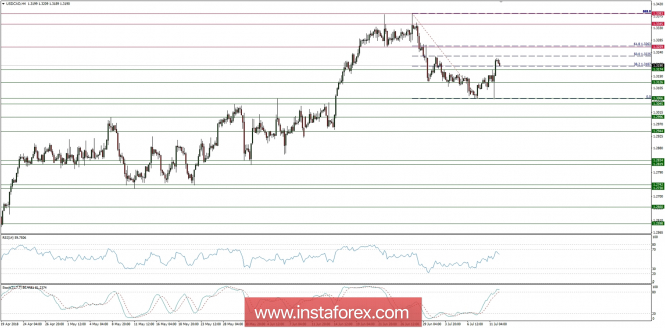In line with market expectations, the Bank of Canada decided to raise interest rates to 1.5%, making them the highest levels in almost a decade. In response to the rate hike, the Canadian dollar strengthened against the dollar and other major currencies by several dozen points.
Although the increase by 25 basis points to 1.5% caused the main interest rate to be at the highest levels for almost a decade, in Canada the environment of very low rates is still in effect as a result of the 2008 financial crisis, when rates slid in over a dozen months from 4.0% to just 0.25%.
According to today's statement of monetary policy and updated economic forecasts, the Bank of Canada (BoC) expects CPI to slow down to 2.5% and return to target levels in the second half of next year. The gross domestic product should amount to 2.0%, and in 2019 2.2%:
"According to the April report on monetary policy (MPR), the Bank expects the global economy to grow by about 3.75% in 2018 and 3.5% in 2019. The US economy turns out to be stronger than expected, which strengthens market expectations for higher interest rates and leads to an increase in the US dollar. This contributes to financial tensions in some emerging market economies. In the meantime, oil prices have risen. The Canadian dollar, however, is lower, which reflects the strong position of the Canadian dollar and concerns about trade activities. The possibility of greater trade protectionism is the most important threat to global perspectives" comments the global Bank of Canada regarding the global macroeconomic situation.
The Governing Council expects higher interest rates to be justified so that inflation remains close to the target, and will continue to adopt a gradual approach based on incoming data. In particular, the Bank monitors the adjustment of the economy to higher interest rates and changes in the scope of production capacity and wage pressure, as well as the reaction of enterprises and consumers to commercial activities. The next hikes are ahead of us, but they require "cooperation" from the strengthening economy.
Let's now take a look at the USD/CAD technical picture at the H4 time frame. After the BoC decision, the market rallied towards the 50% Fibo retracements at the level of 1.3225 and currently, the price is slowly pulling back from the yesterdays local high. The nearest intraday support is seen at the level of 1.3174, so there is still a chance for another rally toward the key technical resistance at the level of 1.3259 (61% Fibo as well). In a case of a failure at the support, the next target for bears is seen at the level of 1.3126.

